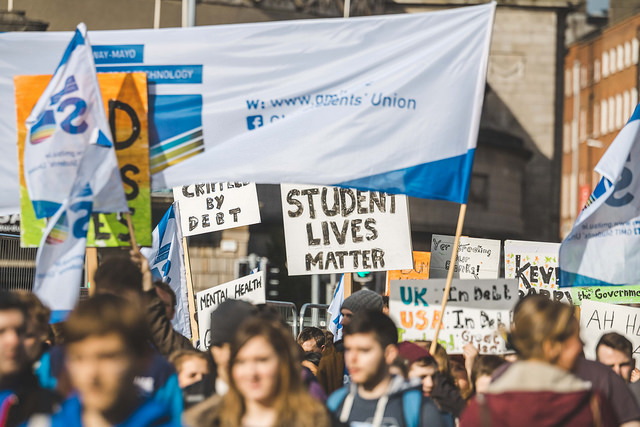After decades of student protesting, the upcoming March for Choice and March for Education have been pitched as a final push to show the strength of opinion and support behind the two issues.
Both issues are set to take to the streets once more in the next week, with the sixth annual March for Choice scheduled for September 30th, and the March for Education, October 4th. With an Oireachtas committee set to issue its take on how to fund third-level education in the next few months and a referendum on the eighth amendment promised within the year, the intensity of future marches could be very different.
Since the 2016 election, the government has yet to take any definitive stance on a funding model for third-level education. Beyond this, there is little to suggest that any conclusive measures will be taken in the short term.
The sense of immediacy is less present in the context of the March for Education as the government continues to mill over the recommendations from the report of its higher education funding working group, published last year. The aim of this march is to demonstrate not only a continued opposition to the introduction of a loan scheme but also, and perhaps more importantly, to represent the broad spectrum of groups affected by the issue. Education campaigners are still struggling to prove that their march is “more than just a student demo”, according to Deputy Secretary General of the Irish Federation of University Teachers (IFUT), Frank Jones, speaking to The University Times.
The view that third-level issues affect only students is something that IFUT specifically hopes the march will combat. This conception, according to Jones, is a significant barrier to forcing action from the government, and ensuring the implementation of full government funding. There needs to be a show of “broad based support among the trade unions and other groups”, in order to do that.
“It is not just students who are in third level at the moment” who are affected, and who will be represented on October 4th, he says. “It’s those that work in the sector, it’s the parents of those that are in the sector, it’s the parents of those who will be in higher education in the future and it’s the students that are in second-slevel education at the moment.”
“There’s a whole society involved in this issue. We want to highlight that”, he said.
The position of participants in the March for Education is clear: this is by no means a final charge. It is, rather, another slow push towards recognition of the issue in the first place. The campaigning will “end in political decision. But it’s not going to happen this year”.
Abortion, on the other hand, is rushing towards some kind of conclusive decision. The Citizens’ Assembly recently voted overwhelmingly in favour of a dramatic liberalisation of abortion law in Ireland. Taoiseach Leo Varadkar has committed to a referendum. For activists, this is a crucial time. Annie Hoey, in charge of Education and Training for the Coalition to Repeal the Eighth, told The University Times: “Hopefully it’s the last time we’re going to have to get active so it’s really important. It’s bringing to the fore the fact that this is it now.”
There is a sense of urgency underscoring this year’s demonstration. Hoey notes that we have the “clearest commitment we’ve had since 1983” from the government on the possibility of a referendum. The tone has changed: “On both sides of the campaign, people are getting themselves ready. This is a battalion march. It is a full call to arms.”
“We’re now speeding toward a referendum of [an] unknown date”, she says, “so you’re running but not entirely sure where to, and a lot of TDs are still on the fence about this”. Moreover, they are not the only side anticipating a referendum: “The opposition to any change in relation to this are quite good at making their voices and opinions known.”
Despite the differences in tone and purpose, however, both campaigns agree on one crucial point: marching alone is not enough. Jones, in particular, is sceptical: “The march in its own right is not going to solve anything. It might highlight the issue.” If it does this, he says, it has served its purpose. Then, what is more important “is that we sit down and talk, rather than walk”.
This is a view echoed by those involved in the March for Choice, who are conscious of the fact that it is “all now in the politicians’ hands about what happens next”. There is a fear, Hoey says, that there will be a dilution of the recommendations of the Citizens’Assembly, which, for her, are the “bare minimum” of what ought to be offered in a referendum.
While the march can be viewed as an important show of strength, more important to the success of the campaign is that people “march to their constituency offices to make contact”. Faces need to be put to issues, and representatives need to be assured and convinced of what “their constituents think”. If not, then the marches will be an empty sentiment.







